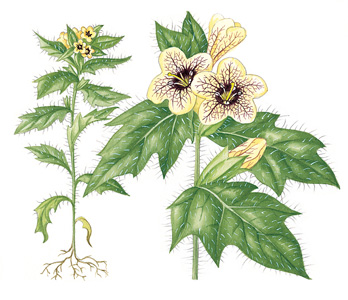Poisonous plant is any plant that can cause sickness or death in human beings or other animals, through contact or consumption. There are many kinds of poisonous plants. Some kinds have only moderately harmful effects. Others contain substances that are among the deadliest poisons.
There are hundreds of kinds of poisonous plants. Many look, smell, or taste disagreeable, and so people and animals avoid them. But even familiar food plants may have poisonous parts. For example, the leaves of potato and rhubarb plants are poisonous, as are the pits of apricots, cherries, and peaches. People should never eat or even chew any part of a plant that they do not know is harmless. In case of possible poisoning, a physician or a poison control center should be called immediately. Poisonous plants have also killed many farm animals.
One of the deadliest plant poisons occurs in the seeds of the rosary pea. Craftworkers in many parts of the world use these pretty red-and-black seeds in making bracelets, necklaces, and rosaries. A person can be killed by eating one rosary pea seed. Another powerful poison occurs in the oleander plant. Some people have died from eating meat roasted on an oleander stick. Other well-known poisonous plants include aconite, belladonna, cassava, croton, the castor-oil plant, hellebore, henbane, jimson weed, and larkspur.
Not all poisonous plants do their harm by being eaten. Some, such as poison ivy and manchineel, irritate the skin or eyes. Certain others, known as allergens, are harmful only to people who are sensitive, or allergic, to them. The pollen of ragweed is an allergen that causes hay fever and asthma. See Allergy.

People make use of many kinds of poisonous plants. Some are lovely garden flowers. Others are used in making insecticides. Many of the most valuable drugs used in medicine are poisons extracted from plants and given in controlled doses. They include aconite, atropine, cocaine, digitalis, hyoscine, morphine, quinine, and strychnine.
